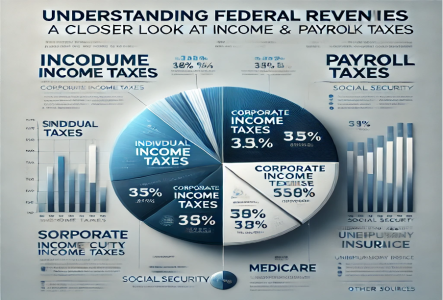Widgetized Section
Go to Admin » Appearance » Widgets » and move Gabfire Widget: Social into that MastheadOverlay zone
Understanding Federal Revenues: A Closer Look at Income and Payroll Taxes
The views expressed are those of the author and do not necessarily reflect the views of ASPA as an organization.
By Biswanath Bhattacharjee
February 10, 2025

Income and payroll taxes form the cornerstone of federal revenue in the United States. These taxes not only fund essential government functions but also support critical social programs, ensuring financial stability and national welfare. In 2023, these two revenue streams collectively accounted for a significant majority of federal revenues, underscoring their indispensable role in the fiscal framework.
Income Taxes: The Largest Source of Federal Revenue
Individual income taxes have long been the primary source of federal revenue, accounting for 48 percent of all federal revenues in 2023. Income taxes are progressive, meaning tax rates increase with higher income levels. This structure ensures that individuals with greater earnings contribute proportionally more, promoting equity in the tax system.
Revenue from income taxes funds a wide range of federal programs, including national defense, education, infrastructure and social services. Additionally, these taxes help address budget deficits and manage national debt, reinforcing the government’s capacity to sustain operations and investments.
Payroll Taxes: Supporting Social Security and Medicare
Payroll taxes, the second-largest source of federal revenue, made up 36.6 percent of all federal revenues in 2023. Unlike income taxes, payroll taxes are specifically earmarked to support Social Security and Medicare, which are vital to millions of Americans. These taxes are imposed on wages and salaries and are shared equally between employers and employees.
Funds raised through payroll taxes ensure the sustainability of these social insurance programs, providing financial security for retirees, individuals with disabilities and others who rely on Medicare for healthcare services. With an aging population and increased life expectancy, payroll taxes are crucial in maintaining the solvency of these programs and meeting growing benefit demands.
Other Revenue Sources for the Federal Government
While income and payroll taxes form the bulk of federal revenues, other sources contribute to the government’s budget, including:
- Corporate Income Taxes: Taxes imposed on business profits are a significant revenue source, reflecting the corporate sector’s contributions to national finances.
- Customs and Duties: Revenue from tariffs on imported goods supports trade regulations and protects domestic industries.
- Sales and Excise Taxes: These are levied on specific goods and services, such as gasoline, tobacco and alcohol, providing targeted funding for federal initiatives.
- Non-Tax Revenue: This category includes earnings from the Federal Reserve, government resource sales and other non-tax income sources, offering financial flexibility for government operations.
Payroll Budgeting: Essential Considerations
Effective payroll budgeting is crucial for businesses to maintain financial stability and compliance with legal obligations. Employers must account for various factors when planning payroll expenses to ensure a balanced budget and smooth operations.
- Benefits: Employers must provide mandatory benefits like Social Security and Medicare contributions, which are non-negotiable payroll expenses. Voluntary benefits, including 401(k) plans, paid time off (PTO), and health insurance, are often offered to attract and retain talent. Factoring these costs into payroll planning is essential for maintaining a competitive and compliant workforce.
- Base Pay: Base pay, which includes the gross wages of both exempt and non-exempt employees, forms the foundation of payroll expenses. Ensuring that base pay aligns with industry standards, job responsibilities and legal requirements is crucial. Regular reviews of pay structures help employers stay competitive while adhering to federal and state wage laws.
- Hiring and Departures: Workforce size fluctuations should be anticipated during the budget period. Employers should consider financial implications related to hiring new employees or potential savings from departures. Recruitment costs, training expenses and severance packages should also be included in payroll budgets to avoid unexpected financial strain.
- Seasonal Changes: Businesses that experience fluctuations in demand, such as retail and hospitality, may need to scale staff levels or hire temporary employees during peak seasons. Factoring in these variations ensures payroll budgets remain adaptable and responsive to seasonal needs.
- Mandatory Increases: Employers must stay informed about changes to minimum wage laws, overtime regulations and salary thresholds, which can significantly impact payroll expenses. Proactive planning ensures compliance and helps businesses avoid penalties.
The Interplay Between Taxes and Payroll
The relationship between federal taxes and payroll is mutually reinforcing. Income and payroll taxes fund essential services, while businesses must carefully plan payroll expenses to meet tax obligations and maintain operational efficiency. Employers act as intermediaries in the payroll tax process, ensuring accurate deductions and timely remittances, which upholds the tax system’s integrity and contributes to national economic stability.
Conclusion
Income and payroll taxes are essential to federal revenue, enabling the government to fund programs and services that benefit society. Income taxes address a broad range of public needs, while payroll taxes sustain Social Security and Medicare. Together, they reflect a commitment to equitable resource allocation and social welfare.
For businesses, understanding and managing payroll obligations is crucial for compliance and fostering a productive workforce. By considering benefits, base pay, workforce changes, seasonal adjustments and mandatory increases, employers can create payroll budgets that align with financial goals and legal responsibilities.
As the backbone of government funding and employer planning, income and payroll taxes highlight the interconnectedness of public and private sectors in shaping a stable and prosperous economy.
Author: Biswanath Bhattacharjee can be reached at [email protected].


 (3 votes, average: 4.33 out of 5)
(3 votes, average: 4.33 out of 5)
Suma Acharjee
February 12, 2025 at 8:53 pm
Great Article!